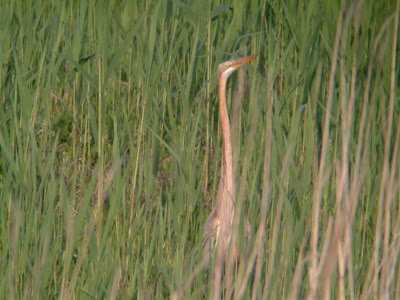 Mishima
MishimaSo my favorite time of year has arrived in Jappers...with my annual pilgrimage to an offshore island only days away, my lips are slavering with the excitement of it all.
As in the previous three of the last five years, I'll be heading out to Mishima island. A 6km by 2km wide piece of rock, in the middle of the Sea of Japan, 1 hour and 20 minutes by ferry from quiet little Hagi on the Japan sea coast of Yamaguchi.




This year I am gonna rough it for the second time and camp, after an attempt last autumn, was curtailed after a few days, because out of the kindness of their hearts the people running the campsite let us stay, but refused to turn on the water for showers etc, as it wasn't peak season.
So what might we expect..well if todays little lunchtime jaunt around Hiroshima Castle is anything to go by, quite a lot. Today at the castle there were 3 male Japanese Thrush, 1 Wryneck and 1 male Siberian Rubythroat. The latter skulking and not playing ball, while the thrushes sung and fought over territory and the Wryneck showed well for a minute before being put up by someone.
Also the Hiroshima WBSJ group just returned from a weekend trip there, where the highlights were Japanese Yellow Bunting, Japanese Murrelet, Siberian Rubythroat, Silky Starling, Little Bunting and Siberian Blue Robin among others.
Last autumn I vsited at the end of September for 2 days and managed to find quite a few goodies, including 3 Japanese rarities - Northern Wheatear ( around 20 records in Japan) ,Common Swift (not officially on Japanese list yet) and Blyth's Pipit, as well as some other scarce species - Middendorf's Grasshopper Warbler, Richard's Pipit, Long-toed Stint, Red-cheeked Starling, White's Thrush, Little Bunting and the one that got away..a swiftlet sp. There were also many Hobby and Kestrel on the island, and the commonest migrants seemed to be Grey Wagtail and Stonechat.
 Kestrel
Kestrel Northern Wheatear
Northern Wheatear Stonechat
Stonechat
Sooty Flycatcher
 Northern Shoveler
Northern ShovelerThe previous spring saw Mark Carmody and I having what can only be described the best spring birding I have had in Japan, even outstripping my trip to Hegura in 2002. Major rarities included Black Drongo (2), Two-barred Greenish Warbler ( 3rd or 4th Japanese record- only me)Blunt-winged Warbler (first Japanese record) and Plain Martin (4th or 5th Japanese record - latter two only Mark, myself and 1 other birder) as well as a huge list of scarcities -Chinese Pond Heron, Silky Starling, Yellow-browed Warbler, Mugimaki Flycatcher, Swinhoe's Robin, Styan's Grasshopper Warbler, Jungle Nightjar, Richard's Pipit, Grey-backed Thrush, Japanese Night Heron (Mark only - I was looking the wrong direction as usual), Japanese Paradise Flycatcher, Siberian Blue Robin, Siberian Rubythroat, Hodgson's Hawk Cuckoo (heard only), Dusky Warbler (heard only), Japanese Robin (heard only), Black-faced Spoonbill (first island record), Little Bunting, Tristram's Bunting, Pintail Snipe, Dollarbird, Oriental Scops Owl (heard only) - the one that got away Lanceolated Warbler. In all we saw 120 species. A new best spring total for me.

Black Drongo

Grey-backed Thrush
 Pintail Snipe
Pintail SnipeSeveral spring trips before that have produced some pretty nice birds too - Black-naped Oriole (1), Black-capped Kingfisher (1), Chestnut Bunting (1), Yellow-browed Bunting (6+), Purple Heron (1), Chinese Pond Heron (2), Japanese Night Heron (1),
Swinhoe's Egret (1), Short-toed Lark (1), Brown Shrike (2), Yellow-rumped Flycatcher (1), Mugimaki Flycatcher (5+).

Black-capped Kingfisher
 Swinhoe's Egret and Little Egret
Swinhoe's Egret and Little Egret Purple Heron
Purple Heron Chinese Pond Heron
Chinese Pond HeronIn total I have seen about 155 species on the island since my first visit in 2000.
Unfortunately past years have seen me miss many of the rarer visitors to the island - Golden Eagle, Spotted Eagle, Chiffchaff, Willow Warbler, Thick-billed Warbler, Palla's Grasshopper Warbler, Little Whimbrel, Hooded Crane, Indian Cuckoo, Pied Wheatear, Ferruginous Flycatcher among others.
This island easily rivals Heguara for variety and numbers of birds, but is far more difficult to cover, as at its highest point it is over 200m, and much of the island is still largely impenetrable scrub! There have been well over 250 species recorded on the island, and it is defintely underwatched, with very few visitors going before or after Golden Week and virtually no-one visiting in the autumn, due to the Japanese holiday system.
Still it is a great place to kick back and relax for a few days and hopefully find some good birds into the bargain.

































